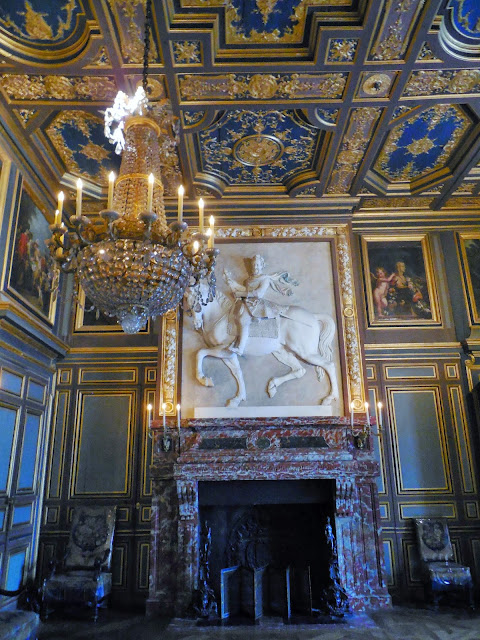(Breakfast this day was a strawberry madeleine, a yummy baked treat for the train ride)
When we arrived in Fontainebleau, we took a bus to the chateau. The first thing we saw when we got off was a large Victorian carousel.
In some ways I enjoyed Fontainebleau even more than Versailles--it was less shiny and felt older, and it really was older! The royal palace started life as a medieval castle, but it has been added onto by many different royals over the years. I really enjoyed that people in period costume wandered the halls, which made for some really fun photo ops!
In some ways I enjoyed Fontainebleau even more than Versailles--it was less shiny and felt older, and it really was older! The royal palace started life as a medieval castle, but it has been added onto by many different royals over the years. I really enjoyed that people in period costume wandered the halls, which made for some really fun photo ops!
The current palace has its origins in the 15th century, when King Francis I commissioned the building of a palace in the "new" Renaissance style--this part of the palace is known as the Cour Ovale, for the oval shaped courtyard the buildings were build around.
We'll start our tour of the inside with the grand apartments:
(The Gallery of Francis I)
The gallery served to connect the state apartments with the oldest chapel in the palace, Saint Saturin:
The ballroom, commissioned by Henry II, was gorgeous!
(fireplace in ballroom)
The Stairway of the King:
(gorgeous ceiling--from the 18th century)
The Room of the Guards:
Three rooms I unfortunately don't remember the names of:
Queen's bedchamber:
Marie Antoinette's boudoir (decorated as it was just prior to her death):
Napoleon also called Fontainebleau one of his homes, and he made some changes, including turning the king's bedchamber into a throne room.
Napoleon wished to have apartments separate from the state apartments, so the following rooms were his private rooms:
The most interesting Napoleon related room, however, was this little room,
which includes the table on which Napoleon abdicated (which he did here in 1814 when the Treaty of Fontainebleau was signed).
Another notable room is the Gallery of Diane, added in the 19th century by King Louis XVIII.
The next group of rooms, in a slightly newer wing of the palace, include the apartments of the Queen-Mothers, which were used in the 16th century by Anne of Austria (wife of Louis XIII and mother of Louis XIV).
balcony over looking this chapel:
By this time we had finished our tour of the palace, so we headed out to the gardens, stopping for a quick lunch at the Orangerie tearoom on the palace grounds.
After finishing the tour of the chateau in the gardens, we boarded the train back to paris and, after arriving, took the metro to the Basilica of St. Denis.
The choir of this church, built in 1144, is considered to be the first gothic church.
The church also had some very pretty stained glass,
(Unfortunately, the church was covered in scaffolding, so I couldn't really see what the exterior would normally look like, but I did get a picture of the bell tower and clock on the front)
(This door depicts the martyrdom of St. Denis)
The church also had some very pretty stained glass,
(French Rayonnant gothic style stained glass --period between 1240 to 1350)
including a beautiful rose window.
Nearly every French king from the 10th to the 18th century was buried here, including Louis XVI and Marie Antoinette.
In the church above the crypts are the tombs of some of the kings and queens (the bodies were removed during the Revolution and put in a mass grave, now those remains are buried in the crypt).
(Memorial to Louis XVI and Marie Antoinette)
(Tomb of Henry II and Catherine de Medici)
(Memorial to Henry II and Catherine di Medici)
The church also had many reliquaries (which are believed to hold bones of saints).
We next head to the market street Rue Cler, which had been recommended by my Rick Steves travel guide. It was just okay. We were hoping to be able to put together a picnic and to take it to eat in a nearby(ish) park, but it was too confusing, so we just got some ice cream before heading up to the park anyway--the park of invalides.
(this cone was shaped like a rose!)
We thought a fancy hotel was in the square, but come to fine out that was the location of the military
museum.
We ended up doing a little more walking than anticipated, but we ended up just walking all the way back to the Rue de Rivoli. We passed over Pont Alexandre II, built in 1900, the fanciest bridge in Paris.
Once we had crossed, we walked towards the Place de la Concorde.
This square is the home of the Obelisque, a gift to France in 1833. This is the Luxor Obelisk, which is 3,000 years old.
Rue de Rivoli runs into this square, so we had arrived. I did a tiny bit of shopping before stopping at a cafe for dinner. Our cafe just so happened to be near a statute of Joan of Arc.
After finishing, we walked up to the Lourve to take a pyramid picture at night.



































































I like how your posts provide the descriptions and history of various rooms in the Chateau. All of my photos of Fontainebleau are captioned very helpfully with things like "interior view" and "exterior view." If I'm not too lazy, I may go back and edit them based on your posts. And thank you for not mentioning how annoying I was about the Fontainebleau stairs. :-P.
ReplyDeleteAlso, in your Rue Cler ice cream action shot, you can see the cookie shop where we bought those delicious fresh cookies!
...I miss Paris.